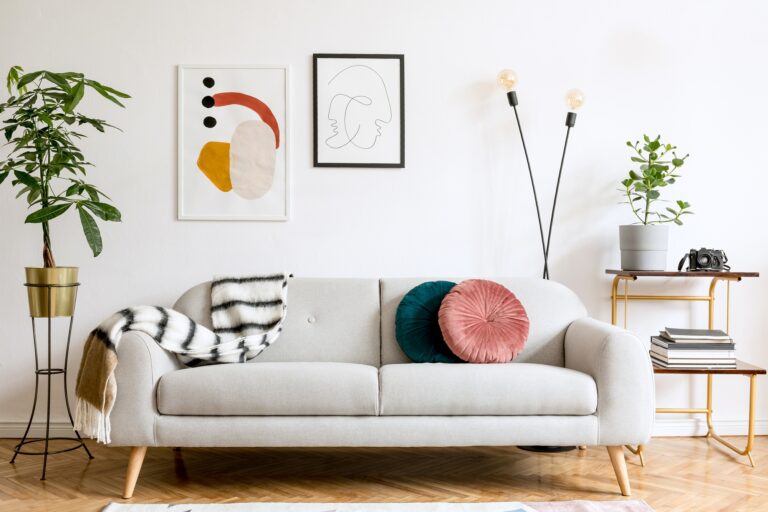A good floor planning tool can save you hours in the design process. Two of the most popular platforms for floor plans today are Planner 5D and Floorplanner. Both of these tools are affordable, easy to use, and produce stunning end results. By digging into their features, pricing models, and online reviews, you’ll be able to pinpoint the platform that can better serve your interior design business.
Table of Contents
What are the main differences between Planner 5D and Floorplanner?
Planner 5D and Floorplanner have more similarities than differences (pricing plans, average reviews, customer support options, and basic features). They feel similar on the client end as well, thanks to link-based design sharing.
Planner 5D starts to stand out when we look into advanced features. The Room Scan feature, for example, lets users upload images of existing spaces and convert them into floor plans with the press of a button. The Smart Wizard AI design tool puts floor plans together for you with your chosen dimensions, products, and styles. And everything in the product library can be edited for color and material for complete customization.
Planner 5D also provides branding opportunities to make your client deliverables feel more professional.
Floorplanner may have fewer advanced features, but sometimes simple is better. Its basic layout is often appealing to designers who only need a tool to create basic floor plans. And even though Floorplanner is easy to use, its high-quality renderings and 3D tours still allow for high-end client deliverables.
Planner 5D VS Floorplanner: Features
Planner 5D is built for creating quick and beautiful floor plans, with features like:
- 2D and 3D floor plans
- Moodboard creator
- Scan Room feature
- Smart Wizard AI design tool
- Editable product library (change items’ colors, patterns, materials, etc.)
- 3D rendering with realistic lighting and shadows
- Platform access from computers, tablets, and smartphones
- Link-based design sharing
- Branding opportunities
Floorplanner’s features are simpler, including:
- 2D and 3D floor plans
- Moodboard creator
- Large product library
- 3D rendering, walkthroughs, and 360 views
- Shareable links
Planner 5D VS Floorplanner: Pricing
Now let’s compare the pricing for these two platforms.
Planner 5D offers four pricing tiers:
- Free: $0/month
Create and share unlimited projects across web and mobile. You can join design challenges and potentially unlock Premium access as a prize. - Premium: $4.99/month (billed annually) or $19.99/month (monthly billing)
Unlocks AI tools like Smart Wizard, 8,000+ premium furniture items, advanced editing (resizing, textures), and limited rendering (5 per month or 60 per year). - Professional: $33.33/month (billed annually) or $49.99/month (monthly billing)
Adds unlimited 4K renders, 360° panoramas, moodboards, custom branding, and the ability to upload custom 3D models. You also get listed in the Top Designers directory for lead generation. - Enterprise: Custom pricing
Tailored for large teams and businesses with white-labeled tools, product configurators, and support for AR/VR and Apple Vision Pro integrations.
Floorplanner uses a credit-based system with optional monthly subscriptions.
You can use Floorplanner for free with up to 5 projects. These come with limited export options (SD images with watermarks and cooldowns). To unlock more features, you either buy credits or subscribe for regular monthly credits and added functionality.
Credit Pricing (one-time purchases):
- 5 credits = $7.90
- 10 credits = $15.80
- 30 credits = $47.40
- 100 credits = $158.00
Subscription Tiers:
- Basic: $0/month
No included credits, 10-minute cooldowns, and limited export features. Good for casual users. - Plus: $5/month
Includes 4 credits monthly, no cooldowns, and access to custom templates and roomtypesets. - Pro: $29/month
Includes 25 credits monthly, plus advanced tools like quick exports, custom watermarks, and premium project defaults.
Since credits are required to upgrade projects or export high-quality visuals, your actual monthly cost with Floorplanner may vary based on how often you need advanced features.
Planner 5D VS Floorplanner: Online Reviews
Planner 5D and Floorplanner have similar online ratings, but Planner 5D has significant more reviews.
Planner 5D has 4.5 stars and 117 reviews on Capterra. It has 4.7 stars and 142 reviews on G2.
Floorplanner has 4.2 stars and 25 reviews on Capterra. It has 4.5 stars and 2 reviews on G2.
Planner 5D VS Floorplanner: Customer Support
Floorplanner’s customer support is largely self-guided. On the Floorplanner website, you can find a downloadable PDF manual, a long list of FAQs, and free weekly webinars (which are available to all plan levels). If you can’t find the answer to your question online, there’s a “contact” form that links to email, but responses may take some time.
Planner 5D has an online contact form with an average response time of 1 hour, making it easy to get answers to specific questions whenever you need them. The website also has a built-in Help Center, where you can find FAQs, support articles, and video tutorials.
Which platform should you choose?
When choosing between Planner 5D and Floorplanner, take a moment to think about your workflow. Do you prefer a simple tool that lets you do everything by hand, or do you want AI assistance?
If you’d like to try assistive features like Scan Room or Smart Wizard, give Planner 5D a try. If you prefer simpler features, stick with Floorplanner.
If you aren’t sure which platform is best for you, consider testing a design with a free account on both sites. You can click through features and compare end results to figue out which platform you prefer.
Simplicity versus customization
Both Planner 5D and Floorplanner offer solid floor planning capabilities, but they shine in different scenarios. Choosing the right tool often comes down to whether you need simplicity or customization.
- When to choose Planner 5D: If you’re working on projects that require extensive customization, branded presentations, or advanced features like AI-assisted design, Planner 5D is the better fit. Tools like the Smart Wizard and Room Scan can speed up your workflow, while 4K renderings and editable product options help you deliver polished, professional results that impress high-end clients.
- When to choose Floorplanner: If your goal is to create quick, clean layouts—especially for real estate, staging, or basic interior mockups—Floorplanner’s simple interface and intuitive tools get the job done with minimal ramp-up time. It’s especially useful for designers who value ease of use over advanced features.
Frequently asked questions
Planner 5D and Floorplanner have similar pricing models. They each offer three plans, one of which is free. The other two plans cost around $5 per month and around $30 per month.
Keep in mind that Floorplanner requires credits to upgrade a variety of features. Since only a few credits come with your monthly subscription, this can quickly turn into an added expense.
Planner 5D offers more professional features to speed up design work and improve end results (AI tools and high-quality 3D rendering). Some designers may love these features, while others will prefer Floorplanner’s simple feel.
Both Planner 5D and Floorplanner are beneficial for interior designers. Planner 5D may feel like the better fit for many interior designers due to its advanced features and branding capabilities. But that isn’t to say Floorplanner can’t be used professionally.
In the end, the platform that best fits your workflow is the right choice for your business. If neither Planner 5D or Floorplanner feel right, check out our ten favorite e-design tools or our top 29 interior design software picks.
Yes. Both platforms offer mobile apps and browser-based tools that work across smartphones and tablets, making it easy to view or edit designs on the go. However, some advanced features—like high-resolution rendering or precise editing—are more intuitive and fully accessible on a desktop. If you’re doing detailed work or using professional tools, you’ll likely prefer the larger screen and expanded functionality of a computer.
Planner 5D offers more client-facing customization tools, like branded deliverables, moodboards, and 4K rendering, making it ideal for designers who want to deliver polished, presentation-ready visuals. These features help elevate the client experience and make your work feel more professional. Floorplanner’s simplicity and shareable links also work well for basic client collaboration—especially for quick approvals or real estate staging—though it lacks branding and customization options that many designers rely on for client-facing work.
Planner 5D offers extensive export options that make it a better fit if you need to take your designs into more technical platforms. You can export projects in CAD-friendly formats like .dwg or .dxf, which are compatible with tools such as AutoCAD and SketchUp. This makes Planner 5D a stronger choice for designers or teams who need to hand off plans to architects or contractors. Floorplanner does not currently offer export options in professional file formats like .dwg or .dxf, so if CAD integration is important to your workflow, Planner 5D will be the more flexible option.
DesignFiles is the top-rated all-in-one platform for interior designers! Learn more and give us a try.


